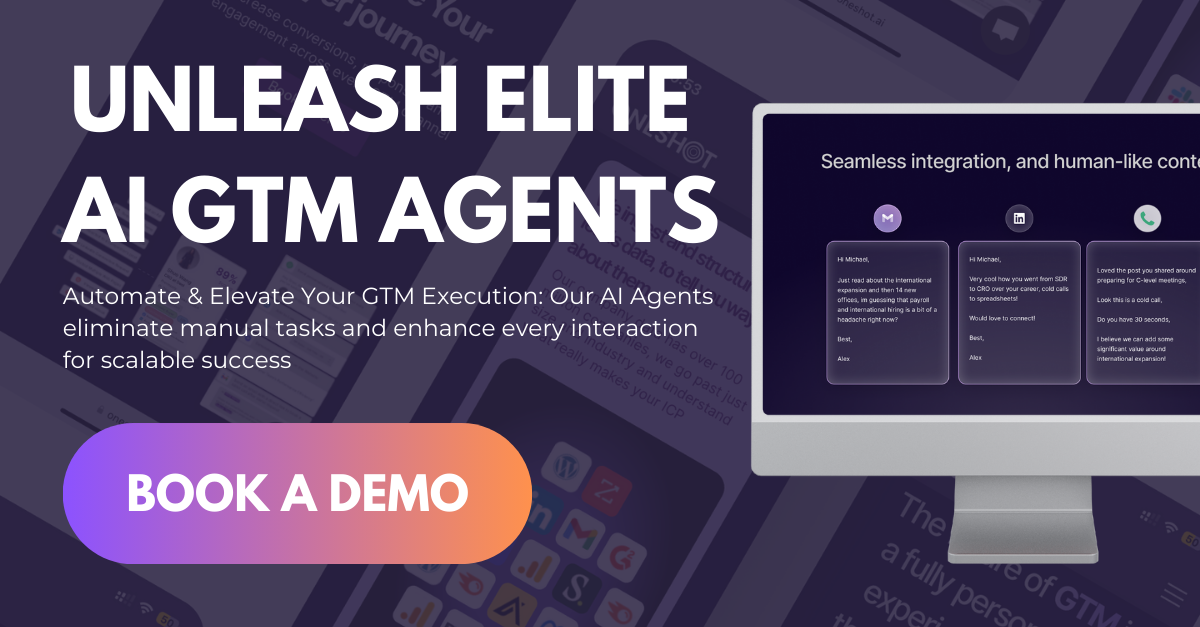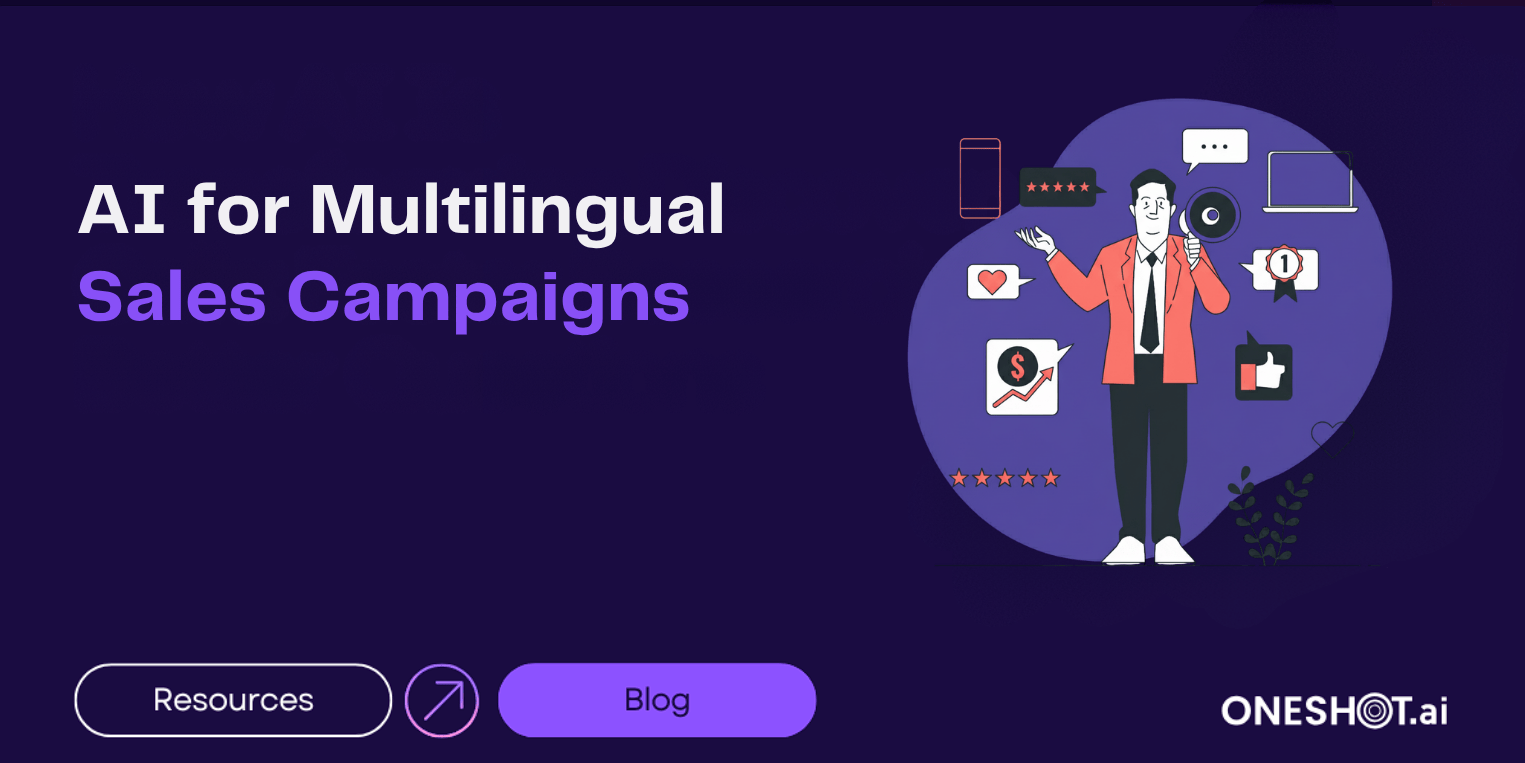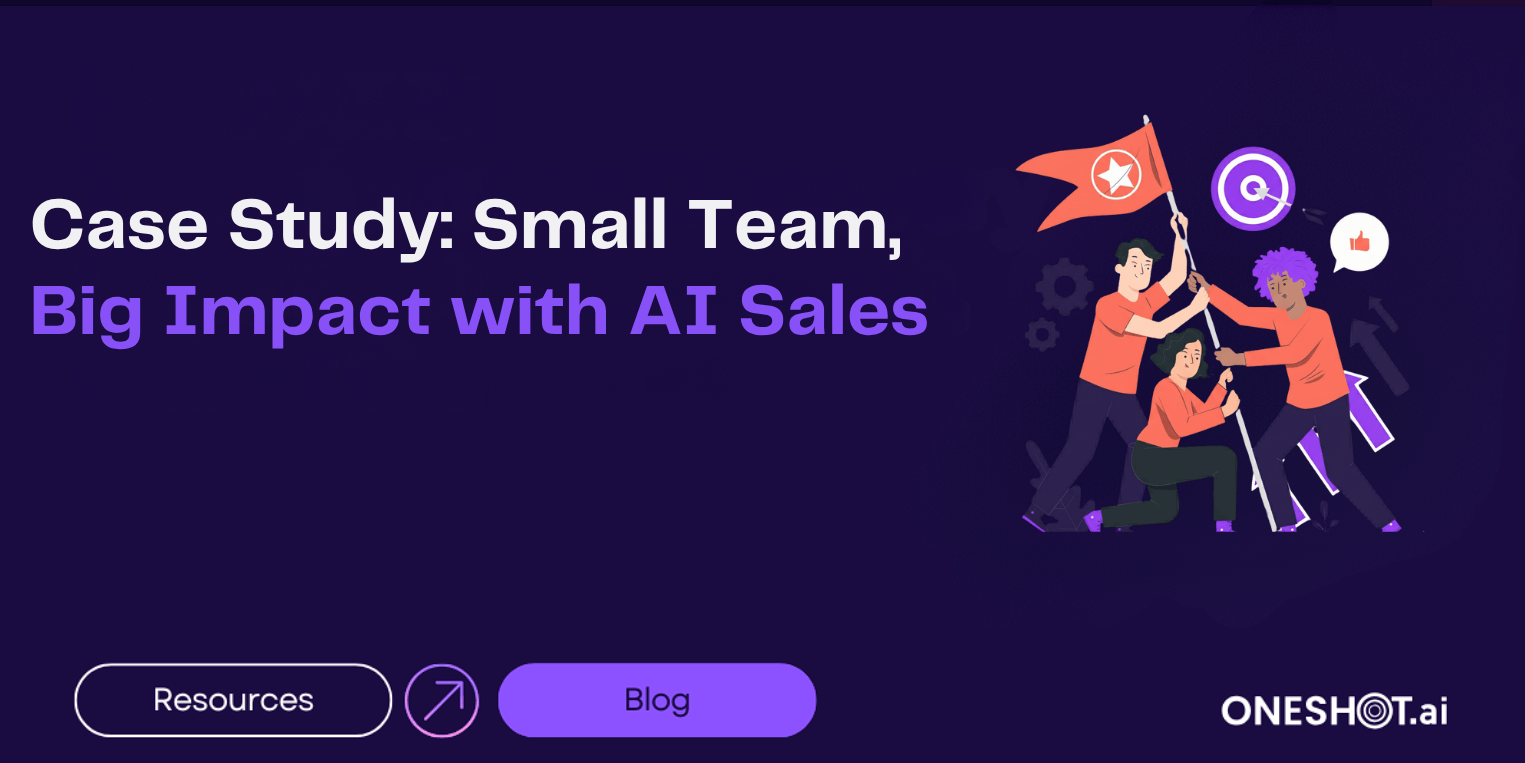In the world today, taking your sales efforts beyond borders isn't a choice—it's a growth imperative. But although venturing into global markets offers immense possibilities, it poses one of the largest obstacles in outbound sales: language.
Account Executives (AEs) and Sales Development Representatives (SDRs) have the daunting challenge of conversing with prospects in many languages, frequently with scarce resources and patchy localization. Here's where artificial intelligence (AI) is making a seismic difference.
Artificial intelligence technologies are empowering sales teams to personalize outreach at scale, tailor messages for local cultures, and remove expensive translation mistakes. From generative language models to persona-based tone adaptation, AI is transforming multilingual sales efficiency on a global scale—enabling teams to convert global prospects with native-like precision.
What Are Multilingual Sales Campaigns and Why Do They Matter in 2024?
Why is multilingual sales outreach essential for global customer acquisition?
As more SaaS and B2B companies go global, being able to engage your leads in their native language has moved from "nice to have" to being a revenue enabler. According to CSA Research, 76% of consumers prefer to buy products in their native language.
The same is true for B2B decision-makers; outreach that personalizes an experience in their native language builds trust, increases response rates, and moves the sales process faster.
How do language barriers impact conversion rates in B2B SaaS sales?
Language barriers almost always create miscommunication, cultural tone-deafness, or generic outreach that does not deliver a good experience. Even small nuances in phrasing can make or break a deal. The more that content feels "translated" as opposed to tailored, the more potential prospects tune out, significantly impacting conversions.
Which industries benefit most from multilingual sales strategies?
Though all global-facing sectors are able to benefit from localization, in particular, SaaS, fintech, e-commerce, and healthcare technology stand out. SaaS, fintech, e-commerce, and healthcare technology often sell across many countries, offer use cases that are regionally specific, and build trust in a short period of time, making multilingual outreach critical for their success.
What are the top languages for global sales outreach in today’s market?
English still leads, but top-tier sales teams now localize outreach in:
- Spanish (Latin America, Southern Europe)
- German (DACH region)
- French (France, Canada, West Africa)
- Portuguese (Brazil)
- Japanese, Korean, and Mandarin (APAC)
How Is AI Changing the Landscape of Multilingual Sales Outreach?
How does AI personalize outreach content across different languages and cultures?
AI does not merely translate—but contextualizes. Contemporary AI algorithms process linguistic data, cultural voice, buyer personas, and even regional purchasing behaviors to produce messages that resonate natively. This transcends language proficiency to incorporate tone-behavioral greetings, time-zone optimization, and value propositions by country.
What role does generative AI play in crafting tone-accurate, locale-specific messaging?
Generative AI applications such as GPT-4 and niche websites like OneShot.ai can create custom email and LinkedIn messages according to local communication standards. For instance, a message to a German executive would employ formal language and orderly content, whereas a message to a Brazilian startup CEO could be informal and emotionally connected.
How is machine translation evolving with contextual accuracy and NLP?
Today's AI translation engine combines natural language processing (NLP) with contextual training. These modern systems evaluate idioms, industry-specific language, and buyer intent, among other variables, to output translation that is fluent and accurate. It goes beyond basic tools such as Google Translate.
What is the difference between AI-generated vs manually translated sales messaging?
Manual translations tend to be static, expensive, and slow to adjust. With AI-generated messaging, material can be adjusted in real-time depending on recipient behavior, A/B testing metrics, and current campaign direction. Quality of the AI output exceeds that of manual efforts if trained properly, often to the point of creating something that reads fluently.

Which Key AI Tools Are Powering Scalable Multilingual Campaigns?
What is the Insight Agent, and how does it capture language-specific buyer intelligence?
The Insight Agent in OneShot.ai interprets market data, buying signals, and persona behavior in each language region. It determines what messaging performs best by country, industry, and buyer role—fueling intelligence into your outbound strategy.
How does the Persona Agent replicate cultural tones and buying styles for different regions?
The Persona Agent shifts tone, voice, and format based on local buyer psychology. It makes sure that your message to a Japanese enterprise CTO comes across completely differently than one to a French marketing director—because it should.
Which AI translation tools integrate well with sales platforms like Salesloft or Outreach?
Top AI tools like DeepL, Lokalise, and OneShot.ai’s own integrations plug into CRMs and sales engagement platforms, making it easy to trigger language-specific sequences directly within Salesloft, Outreach, or HubSpot.
What are the best practices for localizing LinkedIn and email sequences using AI?
- Use templates that are appropriate for the local area.
- Employ AI-enabled A/B testing for all languages.
- Examine performance by region (e.g., open/reply rates in Spain compared to Canada)
- Modify CTAs based on local buying habits.
See all features → https://www.oneshot.ai/features
How Can Sales Teams Scale Personalized Outreach Across Languages Without Compromising Quality?
What is the Scaling Agent, and how does it balance relevance with quantity?
OneShot.ai’s Scaling Agent ensures that multilingual campaigns can reach thousands of leads without sounding robotic. It adapts personalization depth based on buyer priority, allowing high-value targets to receive ultra-tailored messaging, while still maintaining relevance for broader outreach.
How do AI agents synchronize messaging across email, LinkedIn, and in-app conversations?
AI unifies messaging across touchpoints through the utilization of common buyer profiles and journey information. No matter if the rep is sending an email or interacting on LinkedIn, the voice, tone, and content are consistent in the language of the prospect.
What strategies increase engagement when using AI to reach multilingual leads at scale?
- Segment by language and industry
- Customize subject lines to the locale.
- Include local case studies or social proof.
- Use visual and/or formatting choices that resonate culturally.
What performance indicators suggest success in multilingual campaigns?
- Open rates broken down by language or country
- Reply rate by country or region
- Meetings booked for each 100 contacts
- Engagement heatmaps per step in outreach sequences
What Are the Top Challenges in Building Multilingual Campaigns—And How Can AI Solve Them?
How can AI eliminate miscommunication from poorly localized messaging?
AI tools are pre-trained to recognize regional language patterns and tone, thus minimizing the potential for awkward phrasing or literal translations, all while actively adapting the messaging to prevent embarrassing or off-brand mistakes and breaches of trust.
How do AI models handle idioms, tone, and cultural nuance across languages?
When AI is trained on localized datasets, it's not just learning the literal language, but also absorbing cultural context. This allows immediate recognition of idioms that LIT might know don’t really translate and suggest different wording that lands in the culture.
Can AI help sales teams comply with global data regulations during outreach?
Absolutely! AI platforms, such as OneShot.ai, are built by teams who consider regulations—GDPR, CCPA, et al., along with compliance and data privacy laws throughout jurisdictions and for contact outreach.
How does AI automation reduce operational overhead for multilingual prospecting?
AI helps manage translation, personalization, sequence management, and performance tracking, which has cut down manual work by more than 60% while expanding global reach.

What Are the Best Practices for Implementing AI in Multilingual Sales Workflows?
How should companies train and tune AI with brand voice across languages?
Brands should establish tone, values, and messaging guidelines to feed into the training and prompts for the AI platform. This allows for consistency across all languages and platforms.
What KPIs should guide multilingual AI sales performance?
Track:
- Locally relevant accuracy
- Regionally relevant open/reply rates
- Meetings scheduled by language group
- Campaign ROI by region
How can you integrate OneShot.ai with tools like Apollo and HubSpot?
OneShot.ai provides native integrations and workflows that synchronize contact information, launch sequences automatically, and customize touchpoints directly from CRMs such as Apollo and HubSpot.
What cross-functional teams should oversee a multilingual AI campaign's success?
Sales, marketing, localization, and compliance teams must all be involved. A centralized AI performance dashboard assists in aligning these teams towards common campaign objectives.
Automate multilingual outreach while keeping your voice. Get a demo of OneShot.ai’s globally scalable outbound engine.
What Real-World Examples Show AI Succeeding in Multilingual Sales Prospecting?
Case study: How a SaaS enterprise tripled booking rates using OneShot.ai’s multilingual outreach
A B2B SaaS company utilized OneShot.ai to translate their email and LinkedIn sequences in French, German, and Spanish. After 60 days, their booking rates increased by 3.2x, and new market open rates increased by 41%.
Mini case: AI localization vs manual localization
When a sales team A/B tested their French messaging that was personalized by AI against translated messaging they had manually translated, the AI emails had a 24% higher reply rate, which they attributed to better tone, format, and cultural alignment across the messaging content.
Insight from LinkedIn: What sales leaders are saying
Sales leaders are saying that generative AI is enabling reps to operate globally without being multilingual and opening up entire regions that they haven't been able to target in the past due to complexity.
What Are the First Steps to Launching a Multilingual AI-Driven Sales Campaign Today?
How should you assess language needs based on your ICP?
It is necessary to understand where the Ideal Customer Profiles (ICPs) are situated, what their linguistic patterns are, and where your communications are failing due to localization.
What integrations are critical for a seamless multilingual AI workflow?
- You should ensure the AI platform works with:
- CRM, such as HubSpot and Salesforce
- Engagement tools, for example, Outreach and Apollo.
How can OneShot.ai amplify the effectiveness of SDRs and AEs in international markets?
OneShot.ai automates localized outreach across email and LinkedIn, allowing reps to focus on conversations instead of translations.
FAQs
1. How is AI changing sales and marketing in global businesses?
AI is transforming sales and marketing by automating lead generation, improving targeting accuracy, and enabling personalized customer interactions across languages and regions. Businesses now use AI-driven analytics to predict buyer behavior and optimize multilingual campaigns for maximum impact.
2. How is AI impacting international marketing strategies?
AI enhances international marketing by localizing campaigns through natural language processing (NLP), real-time translation, and cultural sentiment analysis. This ensures messages resonate with regional audiences while maintaining brand consistency worldwide.
3. How is Generative AI transforming marketing strategies in businesses?
Generative AI creates dynamic, multilingual content—from product descriptions to personalized emails—tailored to each market. It helps marketing teams scale creative production, improve engagement, and maintain relevance across cultural and linguistic barriers.
4. How is AI changing the advertising industry globally?
AI is revolutionizing advertising through predictive targeting, AI-powered ad copy generation, and multilingual sentiment tracking. Brands can deliver hyper-localized ads to global audiences with real-time optimization based on engagement data.
5. What are the benefits of using AI for multilingual sales campaigns?
AI eliminates manual translation errors, ensures consistency in tone and message, and provides data insights on regional preferences. This results in better customer engagement, higher conversion rates, and improved ROI for global sales initiatives.






.png)

